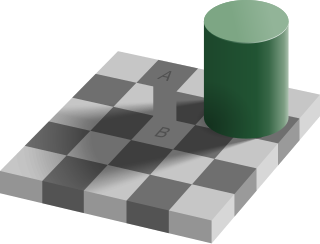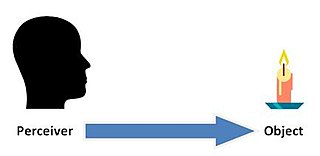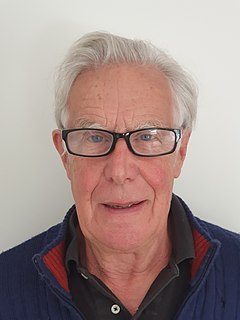Related Research Articles

The philosophy of perception is concerned with the nature of perceptual experience and the status of perceptual data, in particular how they relate to beliefs about, or knowledge of, the world. Any explicit account of perception requires a commitment to one of a variety of ontological or metaphysical views. Philosophers distinguish internalist accounts, which assume that perceptions of objects, and knowledge or beliefs about them, are aspects of an individual's mind, and externalist accounts, which state that they constitute real aspects of the world external to the individual. The position of naïve realism—the 'everyday' impression of physical objects constituting what is perceived—is to some extent contradicted by the occurrence of perceptual illusions and hallucinations and the relativity of perceptual experience as well as certain insights in science. Realist conceptions include phenomenalism and direct and indirect realism. Anti-realist conceptions include idealism and skepticism. Recent philosophical work have expanded on the philosophical features of perception by going beyond the single paradigm of vision.

Perception is the organization, identification, and interpretation of sensory information in order to represent and understand the presented information or environment. All perception involves signals that go through the nervous system, which in turn result from physical or chemical stimulation of the sensory system. Vision involves light striking the retina of the eye; smell is mediated by odor molecules; and hearing involves pressure waves.
An illusion is a distortion of the senses, which can reveal how the mind normally organizes and interprets sensory stimulation. Although illusions distort our perception of reality, they are generally shared by most people.
Auditory illusions are false perceptions of a real sound or outside stimulus. These false perceptions are the equivalent of an optical illusion: the listener hears either sounds which are not present in the stimulus, or sounds that should not be possible given the circumstance on how they were created.

Alfred Rupert Sheldrake is an English author, and researcher in the field of parapsychology, who proposed the concept of morphic resonance, a conjecture which lacks mainstream acceptance and has been characterised as pseudoscience. He worked as a biochemist at Cambridge University from 1967 to 1973 and as principal plant physiologist at the International Crops Research Institute for the Semi-Arid Tropics in India until 1978.

The café wall illusion is a geometrical-optical illusion in which the parallel straight dividing lines between staggered rows with alternating dark and light "bricks" appear to be sloped, not parallel as they really are.

Color vision, a feature of visual perception, is an ability to perceive differences between light composed of different wavelengths independently of light intensity. Color perception is a part of the larger visual system and is mediated by a complex process between neurons that begins with differential stimulation of different types of photoreceptors by light entering the eye. Those photoreceptors then emit outputs that are propagated through many layers of neurons and then ultimately to the brain. Color vision is found in many animals and is mediated by similar underlying mechanisms with common types of biological molecules and a complex history of evolution in different animal taxa. In primates, color vision may have evolved under selective pressure for a variety of visual tasks including the foraging for nutritious young leaves, ripe fruit, and flowers, as well as detecting predator camouflage and emotional states in other primates.
Chromatic adaptation is the human visual system’s ability to adjust to changes in illumination in order to preserve the appearance of object colors. It is responsible for the stable appearance of object colors despite the wide variation of light which might be reflected from an object and observed by our eyes. A chromatic adaptation transform (CAT) function emulates this important aspect of color perception in color appearance models.
Stimulus modality, also called sensory modality, is one aspect of a stimulus or what is perceived after a stimulus. For example, the temperature modality is registered after heat or cold stimulate a receptor. Some sensory modalities include: light, sound, temperature, taste, pressure, and smell. The type and location of the sensory receptor activated by the stimulus plays the primary role in coding the sensation. All sensory modalities work together to heighten stimuli sensation when necessary.

In philosophy of perception and philosophy of mind, naïve realism is the idea that the senses provide us with direct awareness of objects as they really are. When referred to as direct realism, naïve realism is often contrasted with indirect realism.
Steven Peter Russell Rose is an English neuroscientist, author, and social commentator. He is emeritus professor of biology and neurobiology at the Open University and Gresham College, London.

Steven Berlin Johnson is an American popular science author and media theorist.
A sensory cue is a statistic or signal that can be extracted from the sensory input by a perceiver, that indicates the state of some property of the world that the perceiver is interested in perceiving.
Recovery from blindness is the phenomenon of a blind person gaining the ability to see, usually as a result of medical treatment. As a thought experiment, the phenomenon is usually referred to as Molyneux's problem. It is often stated that the first published human case was reported in 1728 by the surgeon William Cheselden. However, there is no evidence that Cheselden's patient, a boy named Daniel Dolins, actually recovered any vision. Patients who experience dramatic recovery from blindness experience significant to total agnosia, having serious confusion with their visual perception.

Michael John Morgan FRS is a Professor at City, University of London.. His area of research is the experimental psychology of vision, from neuroanatomy to perception and psychophysics. He was educated in Cowbridge Grammar School and Queens' College, Cambridge. He was elected a Fellow of the Royal Society in 2005. He is married to the biologist Linda Partridge FRS.
A sense is a biological system used by an organism for sensation, the process of gathering information about the world and responding to stimuli. Although traditionally around five human senses were known, it is now recognized that there are many more. Senses used by non-human organisms are even greater in variety and number. During sensation, sense organs collect various stimuli for transduction, meaning transformation into a form that can be understood by the brain. Sensation and perception are fundamental to nearly every aspect of an organism's cognition, behavior and thought.

Pollard is the debut novel of Laura Beatty, first published in hardback in 2008 by Chatto & Windus and the following year in paperback by Vintage Books. This was her first novel though she had previously written biographies. It won the Authors' Club First Novel Award and was shortlisted for the Ondaatje Prize
Wellcome Book Prize is an annual British literary award sponsored by Wellcome Trust. In keeping with the vision and goals of Wellcome Trust, the Book Prize "celebrates the topics of health and medicine in literature", including fiction and non-fiction. The winner receives £30,000 making it "one of the most remunerative literature awards on offer."

Donald David Hoffman is an American cognitive psychologist and popular science author. He is a professor in the Department of Cognitive Sciences at the University of California, Irvine, with joint appointments in the Department of Philosophy, the Department of Logic and Philosophy of Science, and the School of Computer Science.
Sensory tourism is a form of tourism, that caters for people with vision impairment. Those suffering from vision impairment face many difficulties based around mainstream tourism such as access to information, navigation, safety and the knowledge of others around them. This has caused the visionless members of society to travel much less than those with no vision impairment. Combining the theories behind tourism in terms of its psychology and its relation to the senses, an inclusive experience for the visually disabled was developed. Sensory tourism engages the physical and multi-sensory aspects of tourism, enhancing the tourism experience specifically for those with, but also benefitting those without vision impairment.
References
- 1 2 Through the mind's eye (Review: The Space Between Our Ears), at the Guardian; by Steven Rose; published 24 January 2004; retrieved March 26 2014
- ↑ Reviews: The Space Between Our Ears, reviewed by Peter Thompson; in Perception , 2004, volume 33, pages 255-256